商学部(塾外用) - 慶應義塾大学-塾生HP
商学部(塾外用) - 慶應義塾大学-塾生HP
商学部(塾外用) - 慶應義塾大学-塾生HP
Create successful ePaper yourself
Turn your PDF publications into a flip-book with our unique Google optimized e-Paper software.
Textbooks:<br />
Excerpts from various texts<br />
Reference Books:<br />
1. Bordwell, David and Thompson, Kristin. Film Art: An Introduction,<br />
7th edition (NY, McGraw-Hill, 2004)<br />
GEISHA 2credits (Spring)<br />
「芸者」 2単位 (春学期)<br />
Lecturer GRAHAM, FIONA<br />
講師 グラハム, フィオナ<br />
Course Description:<br />
This course will start with the narrow topic of geisha and spread out<br />
from there to consider the topic on a deeper anthropological level: how<br />
the West views the East, history, myth and tourism, the changing roles of<br />
women, and traditional culture, who decides what is traditional, how and<br />
why does this change, what is lost and what retained, and who controls the<br />
process?<br />
This class will make use of DVDs and other visual resources and may<br />
have a class research trip. The class will have the option of participating<br />
in a banquet at a tea-house with geisha at the end of term.<br />
The course lecturer is an actively working geisha in one of Tokyo’s<br />
geisha districts.<br />
Textbooks:<br />
Students won’t be able to passively rely on a single textbook, but will<br />
need to actively participate in collecting their own research materials from<br />
books, media, video and internet, and may be asked to make contributions<br />
to an online forum or to a class web-site.<br />
Reference Books:<br />
A list of reference books and web-sites will be distributed at the start of<br />
term. However, much information will be gathered on the internet, or<br />
through research by students.<br />
JAPANESE BUDDHISM AND SOCIAL SUFFERING 2credits<br />
(Spring)<br />
日本仏教と現代社会 2単位 (春学期)<br />
Priests and Temples Reviving Human Relationship and Civil Society<br />
僧侶と寺による人間関係と市民社会の再生<br />
Lecturer WATTS, JONATHAN S.<br />
講師 ワッツ, ジョナサン S<br />
Course Description:<br />
This course will look at Buddhism in Japan in a very different way –<br />
through the actions of Buddhist priests and followers to confront the real<br />
life problems and suffering of people in Japan today. We will look at such<br />
issues as: 1) human relationships (alienation, depression, suicide,<br />
hikikomori, and NEET); 2) development (social and economic gaps, aging<br />
society, community breakdown and depopulation of the countryside); 3)<br />
the environment and consumption; 4) politics and peace; and 5) gender.<br />
The creative solutions some individual Buddhists are developing in<br />
response to these problems mark an attempt to revive Japanese Buddhism,<br />
which is now primarily associated with funerals and tourism. These<br />
efforts are trying to remake the temple as a center of community in an<br />
increasingly alienated society.<br />
This course will use a variety of teaching methods from homework<br />
readings, games and group processes, in-class videos and guest speakers,<br />
and occasional field trips. This course will attempt to be as interactive as<br />
possible, so students should be ready to reflect on the issues personally as<br />
they experience them as residents of Japan, and to express these<br />
reflections not only intellectually but emotionally as well.<br />
Textbooks:<br />
none, materials offered by instructor<br />
Reference Books:<br />
Stephen Covell, Japanese Temple Buddhism: Worldliness in a Religion<br />
of Renunciation, University of Hawaii Press, 2006.<br />
Jeff Kingston, Japan's Quiet Transformation: Social Change and Civil<br />
Society in the 21st Century, RoutledgeCurzon, 2004.<br />
93<br />
SEMINAR 1credit (Fall)<br />
演習 1単位 (秋学期)<br />
Reading Yukichi Fukuzawa<br />
Professor, Faculty of Economics SAKAMOTO, TATSUYA<br />
経済学部教授 坂本 達哉<br />
Course Description:<br />
This course will center on the theme of Keio University’s founder<br />
Yukichi Fukuzawa (1835-1901), his thought and its legacy to our time.<br />
Among his numerous works, both academic and popular, is<br />
“Encouragement of Learning”(『学問のすすめ』), as the single mostwidely<br />
read and influential. This course will read this classical text on<br />
chapter-by-chapter basis in English from various points of view.<br />
Prospective students will be welcome who are seriously interested in one<br />
of the greatest intellectual leaders of the time. Any prior knowledge of<br />
Fukuzawa’s life and work will not be required.<br />
This course will also be offered at International Center for international<br />
students. I strongly expect that the course will present a fruitful<br />
opportunity for intellectual exchanges between Japanese and non-<br />
Japanese students. Official language of this course will be English, but<br />
some subsidiary use of Japanese will be allowed.<br />
Textbooks:<br />
English copy of the work will be provided.<br />
Reference Books:<br />
Throughout the course, a number of reference works will be introduced.<br />
CHRISTIANITY IN JAPANESE HISTORY 2credits (Fall)<br />
日本キリスト教史 2単位 (秋学期)<br />
A case study of cross-cultural contact<br />
Professor, Faculty of Economics BALLHATCHET, HELEN J.<br />
経済学部教授 ボールハチェット, ヘレン J<br />
Course Description:<br />
Christianity in Japan presents us with a number of paradoxes. For<br />
example, although the majority of Japanese today choose Christian-style<br />
weddings, the actual number of Christians amounts to less than one or two<br />
per cent of the total population (as opposed to 25 per cent in its close<br />
cultural neighbour, South Korea). This ‘failure’ contrasts with the<br />
relatively greater growth of Christianity in the late sixteenth and early<br />
seventeenth centuries, even though the total number of missionaries was<br />
much smaller and the linguistic and logistical barriers greater. Perhaps the<br />
greatest paradox occurred after Christianity was virtually eliminated<br />
through an increasingly severe campaign of persecution from 1614<br />
onwards. Small groups in isolated communities succeeded in preserving<br />
recognisably Christian beliefs and practices. However, many of these<br />
groups refused to accept the authority of Roman Catholic missionaries<br />
when they returned to Japan in the second half of the nineteenth century.<br />
In the course we will consider these and other issues, using a<br />
combination of primary and secondary materials. By studying the<br />
activities and ideas of missionaries, Japanese Christians, and Japanese<br />
who did not become Christian, students will gain general understanding of<br />
the dynamics of cross-cultural contact. They will also learn about the<br />
nature of history through interpreting primary materials and studying<br />
different approaches to the history of Christianity in Japan.<br />
Textbooks:<br />
There will be a selection of assigned readings for each class. They will<br />
be available for downloading from keio.jp, with notes on each reading<br />
available on my web site (http://web.hc.keio.ac.jp/~hjb/). Students will<br />
find it useful to start the course with a basic knowledge of Japanese<br />
history, Japanese religion, and Christianity.<br />
諸<br />
研<br />
究<br />
所




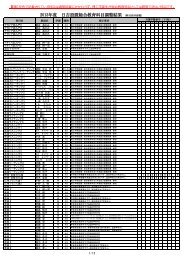
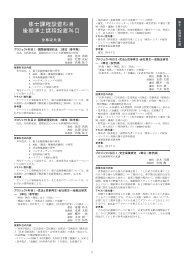
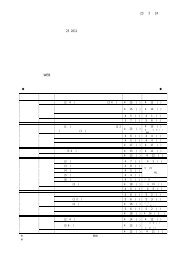
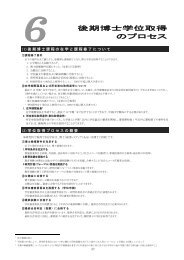
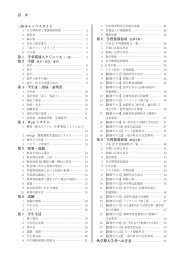



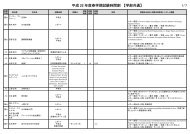

![文学部時間割表[2 ・3年生(07学則)]](https://img.yumpu.com/21046130/1/184x260/2-307.jpg?quality=85)

